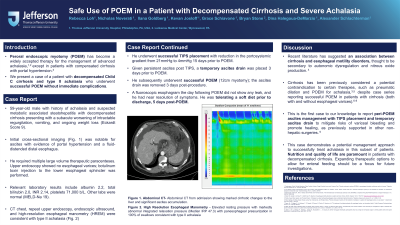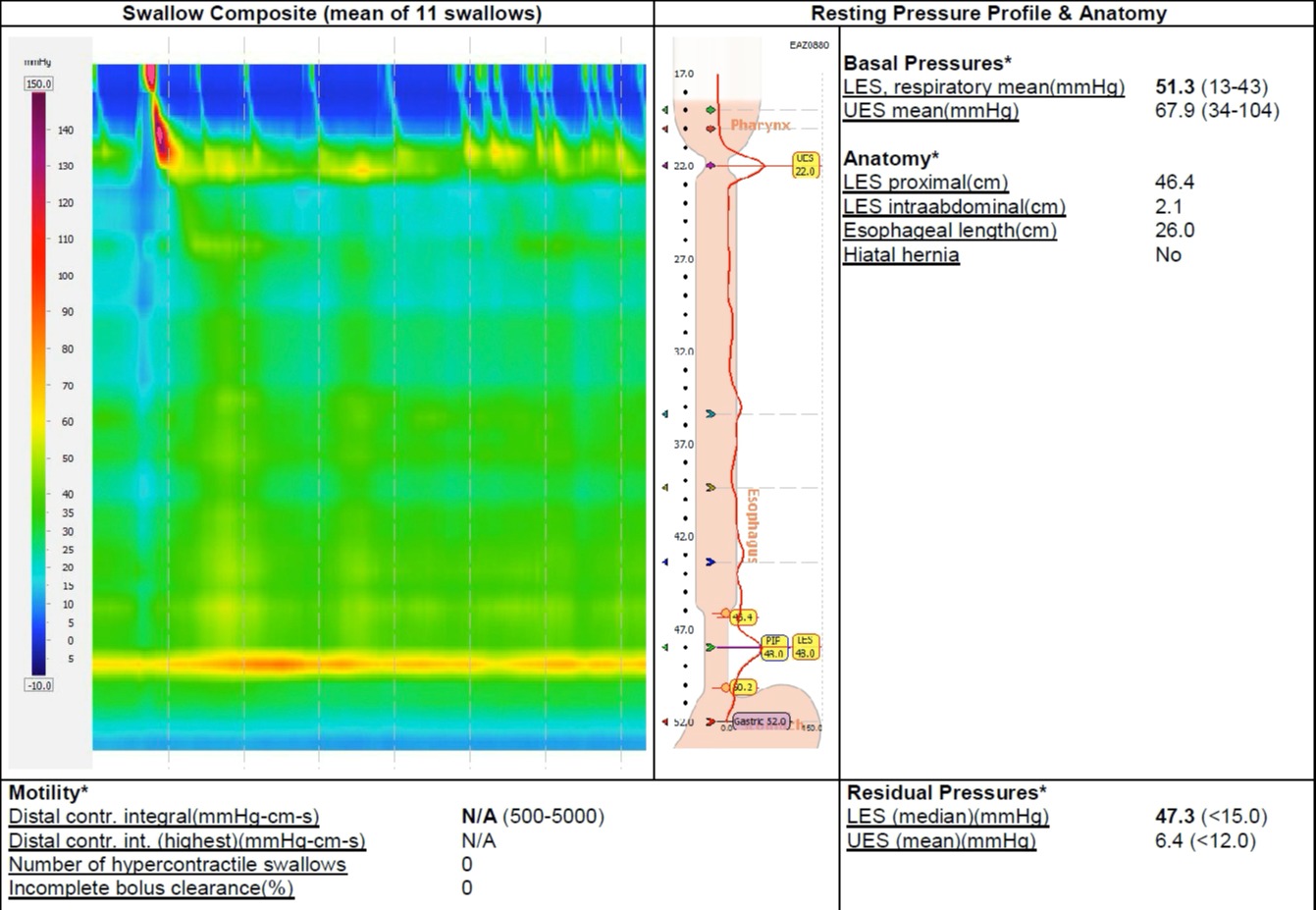Monday Poster Session
Category: Liver
P2590 - Safe Use of POEM in a Patient with Decompensated Cirrhosis and Severe Achalasia
Monday, October 23, 2023
10:30 AM - 4:15 PM PT
Location: Exhibit Hall

Has Audio

Kevan Josloff, MD, MPH
Thomas Jefferson University Hospital
Philadelphia, PA
Presenting Author(s)
Rebecca Loh, MD1, Nicholas Noverati, MD1, Ilana P. Goldberg, MD1, Kevan Josloff, MD, MPH1, Grace Schiavone, BA2, Dina Halegoua-DeMarzio, MD1, Alexander Schlachterman, MD1
1Thomas Jefferson University Hospital, Philadelphia, PA; 2Thomas Jefferson University, Philadelphia, PA
Introduction: Peroral endoscopic myotomy (POEM) has become a widely accepted therapy for the management of advanced achalasia but has been typically considered contraindicated in compensated cirrhosis with portal hypertension.
Case Description/Methods: A 59-year-old male with history of achalasia and decompensated nonalcoholic steatohepatitis cirrhosis (MELD-Na 19) presented with 4 months of abdominal distention, dysphagia, and a 10-lb weight loss (Eckardt Score 9). Cross-sectional imaging revealed ascites and a fluid-distended distal esophagus. He required multiple large volume paracenteses and underwent upper endoscopy that showed no evidence of esophageal varices with botulinum toxin injection to the lower esophageal sphincter. He was started on total parenteral nutrition before being transferred to a tertiary care center for further management.
On arrival, he underwent repeat upper endoscopy, endoscopic ultrasound (EUS) and high-resolution esophageal manometry (HREM) which were consistent with type II achalasia. Following multidisciplinary discussion, we proceeded with transjugular intrahepatic portosystemic shunt (TIPS) placement. Given persistent ascites post-TIPS, a temporary ascites drain was also placed before attempting POEM. The POEM was successful with fluoroscopic esophagram post-procedure day 1 confirming no leak. His symptoms dramatically improved and he was tolerating a soft diet prior to discharge.
Discussion: Cirrhosis has been considered a contraindication to pneumatic dilation and POEM for achalasia but previous case series have reported successful POEM in this population (both with and without esophageal varices). Uniquely, this case report describes large volume ascites that was managed peri-POEM with TIPS and a temporary ascites drain. Peri-procedural TIPS has been reported in other non-hepatic surgeries. In our case, TIPS was also done to theoretically mitigate the risk of variceal bleeding by relieving portal hypertension.
Recent literature has suggested a link between cirrhosis and esophageal motility disorders, thought to be due to autonomic dysregulation in the setting of increased nitrous oxide production. This case provides a potential management approach for treating patients with decompensated cirrhosis. Nutrition and quality of life are paramount in this patient population. Thus, expanding therapeutic options to allow for enteral feeding, such as with high-risk POEM, should be a focus for future investigations.

Disclosures:
Rebecca Loh, MD1, Nicholas Noverati, MD1, Ilana P. Goldberg, MD1, Kevan Josloff, MD, MPH1, Grace Schiavone, BA2, Dina Halegoua-DeMarzio, MD1, Alexander Schlachterman, MD1. P2590 - Safe Use of POEM in a Patient with Decompensated Cirrhosis and Severe Achalasia, ACG 2023 Annual Scientific Meeting Abstracts. Vancouver, BC, Canada: American College of Gastroenterology.
1Thomas Jefferson University Hospital, Philadelphia, PA; 2Thomas Jefferson University, Philadelphia, PA
Introduction: Peroral endoscopic myotomy (POEM) has become a widely accepted therapy for the management of advanced achalasia but has been typically considered contraindicated in compensated cirrhosis with portal hypertension.
Case Description/Methods: A 59-year-old male with history of achalasia and decompensated nonalcoholic steatohepatitis cirrhosis (MELD-Na 19) presented with 4 months of abdominal distention, dysphagia, and a 10-lb weight loss (Eckardt Score 9). Cross-sectional imaging revealed ascites and a fluid-distended distal esophagus. He required multiple large volume paracenteses and underwent upper endoscopy that showed no evidence of esophageal varices with botulinum toxin injection to the lower esophageal sphincter. He was started on total parenteral nutrition before being transferred to a tertiary care center for further management.
On arrival, he underwent repeat upper endoscopy, endoscopic ultrasound (EUS) and high-resolution esophageal manometry (HREM) which were consistent with type II achalasia. Following multidisciplinary discussion, we proceeded with transjugular intrahepatic portosystemic shunt (TIPS) placement. Given persistent ascites post-TIPS, a temporary ascites drain was also placed before attempting POEM. The POEM was successful with fluoroscopic esophagram post-procedure day 1 confirming no leak. His symptoms dramatically improved and he was tolerating a soft diet prior to discharge.
Discussion: Cirrhosis has been considered a contraindication to pneumatic dilation and POEM for achalasia but previous case series have reported successful POEM in this population (both with and without esophageal varices). Uniquely, this case report describes large volume ascites that was managed peri-POEM with TIPS and a temporary ascites drain. Peri-procedural TIPS has been reported in other non-hepatic surgeries. In our case, TIPS was also done to theoretically mitigate the risk of variceal bleeding by relieving portal hypertension.
Recent literature has suggested a link between cirrhosis and esophageal motility disorders, thought to be due to autonomic dysregulation in the setting of increased nitrous oxide production. This case provides a potential management approach for treating patients with decompensated cirrhosis. Nutrition and quality of life are paramount in this patient population. Thus, expanding therapeutic options to allow for enteral feeding, such as with high-risk POEM, should be a focus for future investigations.

Figure: Results of high resolution esophageal manometry (HREM) demonstrating elevated integrated relaxation pressure (IRP), failed peristalsis and panesophageal pressurization consistent with type II achalasia
Disclosures:
Rebecca Loh indicated no relevant financial relationships.
Nicholas Noverati indicated no relevant financial relationships.
Ilana Goldberg indicated no relevant financial relationships.
Kevan Josloff indicated no relevant financial relationships.
Grace Schiavone indicated no relevant financial relationships.
Dina Halegoua-DeMarzio: Pfizer – Advisory Committee/Board Member.
Alexander Schlachterman: FujiFilm – Consultant. GI Supply – Consultant. Lumendi – Consultant. Olympus – Consultant.
Rebecca Loh, MD1, Nicholas Noverati, MD1, Ilana P. Goldberg, MD1, Kevan Josloff, MD, MPH1, Grace Schiavone, BA2, Dina Halegoua-DeMarzio, MD1, Alexander Schlachterman, MD1. P2590 - Safe Use of POEM in a Patient with Decompensated Cirrhosis and Severe Achalasia, ACG 2023 Annual Scientific Meeting Abstracts. Vancouver, BC, Canada: American College of Gastroenterology.
